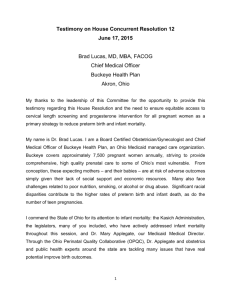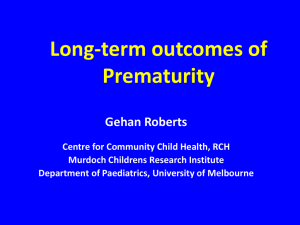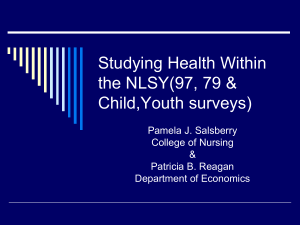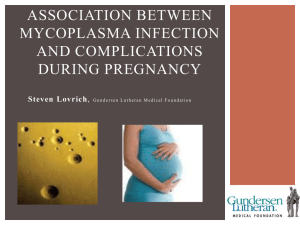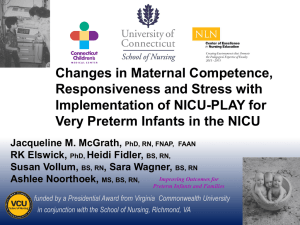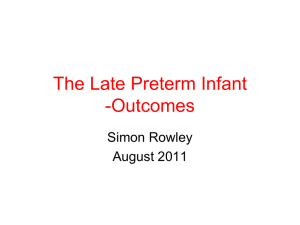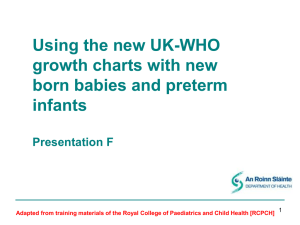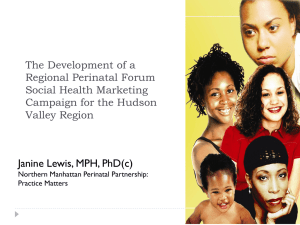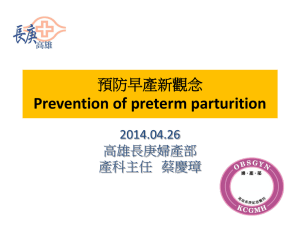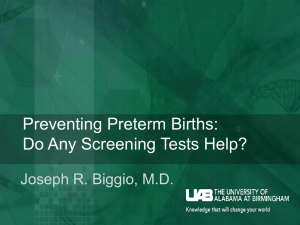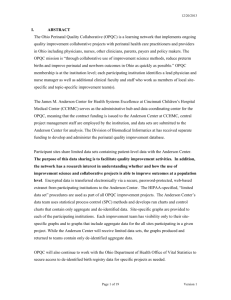Preterm Birth & Infant Mortality: The Obstetricians`s Responsibility
advertisement
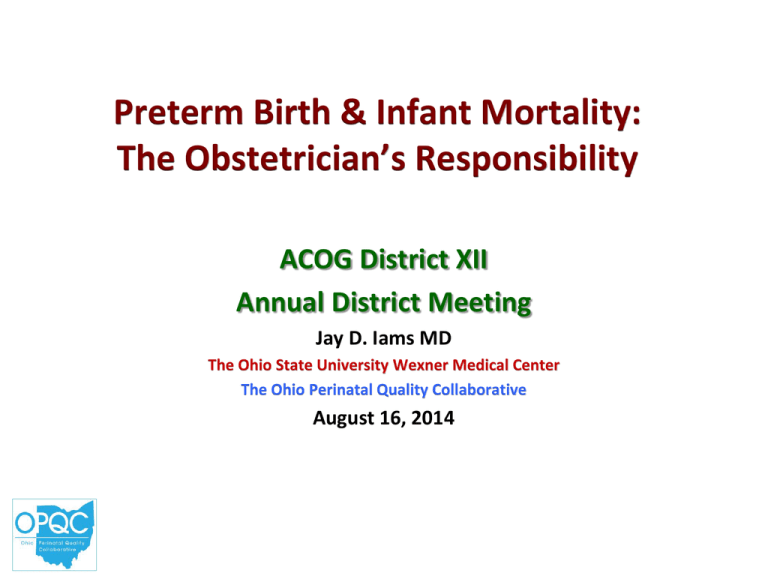
Preterm Birth & Infant Mortality: The Obstetrician’s Responsibility ACOG District XII Annual District Meeting Jay D. Iams MD The Ohio State University Wexner Medical Center The Ohio Perinatal Quality Collaborative August 16, 2014 Disclosures Dr. Iams has contracts via Ohio State University with: •NICHD for clinical research projects •OPQC for quality improvement projects •Elsevier for editorial & authorship roles in AJOG and Creasy & Resnik’s MFM textbook Objectives At the close of this presentation, you should want & be able to: 1. Accept Your Obstetrical Responsibility to Reduce Infant Mortality. 2. Adopt 2 OB “Band-Aids®” to Do # 1. • Hint: Adopt systems to ensure 2 Rx’s 3. Embrace FPQC’s Projects in Your Practice and in Your Hospital. The Ohio Perinatal Quality Collaborative Obstetrics 39-Week Scheduled Deliveries without medical indication Neonatal ANCS for women at risk for preterm birth (240/7 - 33 6/7) Done Transition to BC Surveillance 2013-2015 Increase Birth Data Accuracy & Online modules Spread to all maternity hospitals in Ohio BSI: High reliability of line maintenance bundle Progesterone for Preterm Birth Risk Use of human milk in infants 2229 weeks GA Neonatal Abstinence Syndrome Prematurity is the Most Common Cause of Infant Mortality 34.3% of Infant Deaths Are Caused by Preterm Birth 2010 Infant Mortality Rates March of Dimes 2013 Report Card Premature Birth Rate Rates of Contributing Factors 2012 2013 Uninsured Women Late Preterm Birth Women Who Smoke 17.8% 8.2% 30.6% 17.0% 8.1% 27.3% Grade The Medical Model of Care for Preterm Birth • Tertiary – After Parturition Starts o Improve Outcomes in Preterm Infants Steroids o No Effect on Incidence • Secondary – Find & Reduce Risk o Before and During Pregnancy o In Individuals and Groups • Primary - Prevention of Risk o In Women, Before Pregnancy, Before Menarche o In Systems Care for Preterm Birth During Pregnancy 1985 - 2006 Detection & Suppression of Contractions Detection & Suppression of Infections Detection & Replacement of Nutrients Calcium, Omega-3, Protein, Vitamins C + E Detection & Surgical Rx of Short Cervix Detection & Attention to Social Support Progesterone ??? 1996 - 2012 11.9% 11.7% 11.5% 2010 2011 2012 Who Decreased the Preterm Birth Rate? • Obstetrician Gynecologists? • Maternal Fetal Medicine Subspecialists? • Midwives and Family Physicians? • • • The Leadership Did It - Not the Research Program ! They Publicized Available Data ASRM Statements On Fertility Care And Twins, Triplets, & Higher Order Multiples * Report issued Nov 2011 by CDC – NCHS * OPQC 39 Weeks Project in Sustain Phase Decreasing Non-Medically Indicated Scheduled Deliveries Between 37 and 39 Weeks Gestation 5% Goal Data Is From All Ohio Maternity Hospitals 105 of 107 Hospitals Participated in the OPQC 39 Week Project 14 1996 - 2012 • Ultrasound Dating • Fertility Rx • Sched PTB > 34 wk • Fertility Rx • Sched Birth • Progesterone? 11.9% 11.7% 11.5% 2010 2011 2012 Obstetricians Have The Band Aids • Antenatal Steroids o Review Documentation of ANCS Use o Systems Improvements in Birth Registry o Publish Rates of Documented Use • Progesterone Supplementation o Women with a prior preterm birth o Women with short cervix in this pregnancy Birth Registry Documentation of ANCS Use Aggregate Rate in 19 OPQC Sites 2006 - 2014 Red Arrow: Ohio Hospital Compare Blue Arrow: OPQC ANCS Project Birth Registry Data 2006 2014 The Ohio OPQC Progesterone Project • Goal: Reduce Ohio PTB & Related Infant Mortality o Reduce Preterm Birth < 37 & 32 Weeks by 10% by 7-1-15 • Find Women with Prior Preterm Birth • Find Women with Short Cervix • Make it Easy to Prescribe and Rx Progesterone o Protocols, Medicaid & Insurance Support, Navigators • Outcome Measures o Preterm Birth Rate • Medicaid Data • Birth Registry Data – Births < 32 & 37 Weeks o Process Measures o The Infant Mortality Rate Why? Preterm Birth Largest Contributor to Infant Mortality Preterm Birth Largest Driver of Disparity in PTB Who? Women with a Prior Preterm Birth Women with Very Short Cervical Length How? Find & Rx Candidates for Progestogens When? ASAP – in Ohio & in Each Pregnancy Find a Progesterone Protocol You Like And Use It. Here’s One. Find One That Fits Your Practice. Fundamental Principles Only You Can Prevent Preterm Birth Every Pregnancy Has Some Risk of PTB Preterm Parturition Starts Early in 1st or 2nd Trimester Short Cervix = Preterm Parturition Progesterone Can Slow Preterm Parturition It does not prevent the process Starting Progestogen Rx ASAP is Very Important Finding & Treating Requires Time, So HURRY UP What Formulations of Progestogens Should Be Used? Standard Answers: Hx SPTB: 17-OHPC 250 mg IM Q 7d 16 36 wks Short Cx ≤ 20 mm: Vag P, 200 mg QHS, Dx 36 wks But Life is Not That Simple 17-OHPC – Manufactured vs. Compounded Cost vs. Hassle Vaginal P – multiple formulations - which to Rx? Who pays for what, when, & after how much hassle? Initiate Progesterone ASAP for Hx SPTB Accelerated 1st Prenatal Visit Presumptive Eligibility for Antenatal Care Adopt a Local Management Protocol For Hx SPTB For Short Cervix Test them via OPQC ! Make “Screen for PTB Risk” ≈ GBS, Rh, GDM The Importance of Credentialing for Cervical Sonography Iams JD et al. Am J Obstet Gynecol 2013 https://www.perinatalquality.org/C LEAR/ http://www.fetalmedicine.com/fm f/online-education/05-cervicalassessment/ OPQC’s Tasks: Remove Administrative Barriers to Receiving Progesterone Supplementation Pharmacy Coordination Insurance / Medicaid Coverage & Protocols Delivery and Administration of 17 α- OHPC Use of Vaginal Formulations Generic 200 mg capsules = cheapest & fastest Rx Designate a Progesterone Coordinator Convene Participants to Assure Rx Received Why Are We Missing P-Eligible Women? What Have You Told OPQC About That? • Do Providers Know About Progesterone? Yes. • Do Providers Know What to Rx? Yes, mostly. • Do Providers Know The Rx Gets to Patient? Not So Much. • Do Providers Know Why Women Don’t Seek Care ‘til It’s Too Late? Yes, mostly. •Do Providers Know What They Can Do To Overcome That? Not So Much. What Have Providers Done About Late for Care? • No Appointment Needed! – 1st Visits Welcomed Anytime in Cincinnati • Community Open Houses with Food Prep – “Moms2B” in Columbus Builds Social Networks • Business Community Involvement – Ohio Metro Counties Have High Infant Mortality • High Infant Mortality = A Measure of Community Health – Bring Your Business Here? No Way! Goin’ to Georgia! • Hospital Geographic Responsibility for Health Improving Access to Progesterone in Ohio • Drive Community Changes to Increase Awareness of PTB as Cause of Infant Mortality • Increase Avenues to Enter Prenatal Care • Recognize Candidates at First Contact • Accelerate Appts & THEN get detailed OB Hx • Track Receipt of Progesterone After Rx • Think Outside the Medical Paradigm to Find Eligible Women Late To Prenatal Care Recommendations • Publish The Data for Your County & Your State: o Infant Mortality, Preterm Birth, & Smoking. o Scheduled Births < 39 Weeks – 1% goal. o Multi-fetal Pregnancy Rates. o Antenatal Corticosteroids. o Include Racial Disparity Rates for All the Above. • Track All Over Time – Use Graphs, Not Tables. • Promote Public Awareness o Risks of Preterm Birth o Prevention with Progesterone o Availability of Cervical Ultrasound
